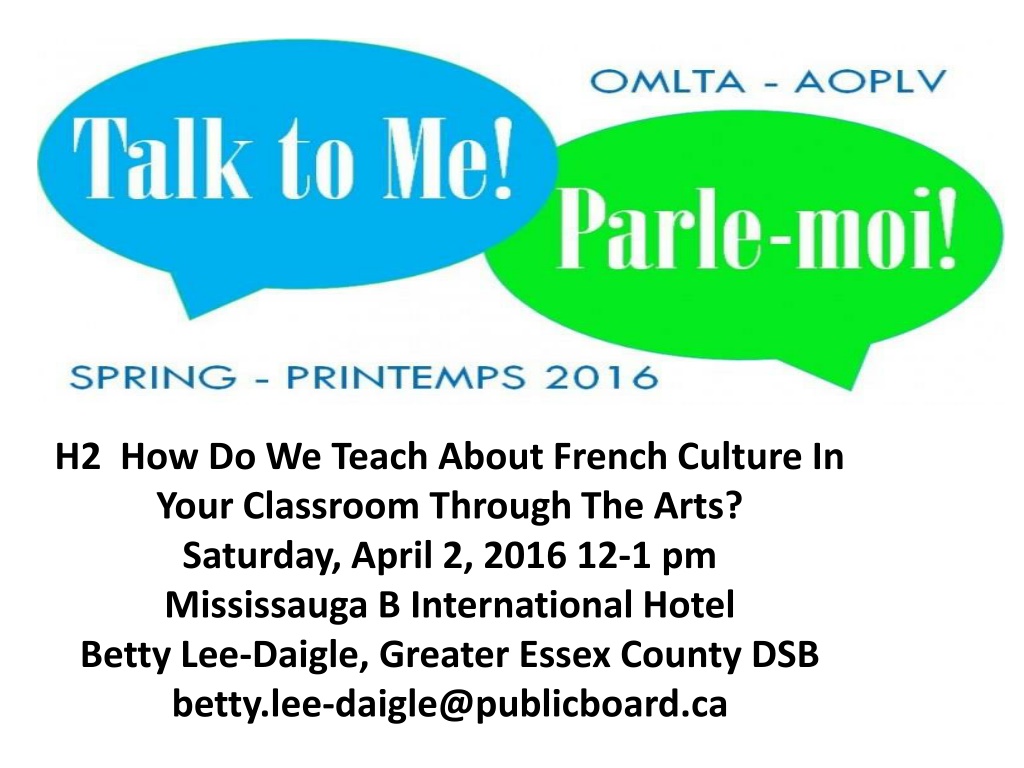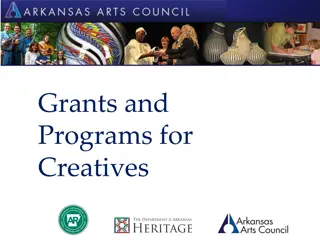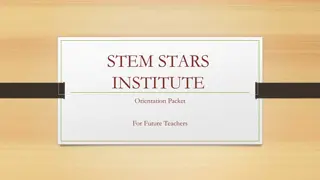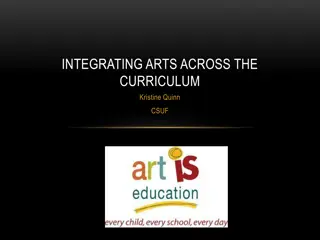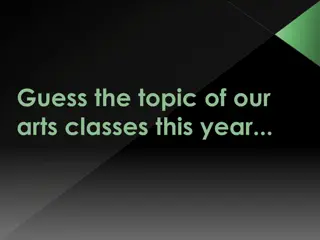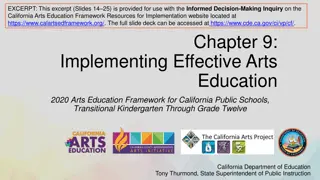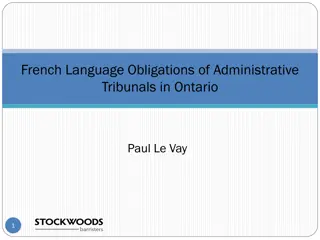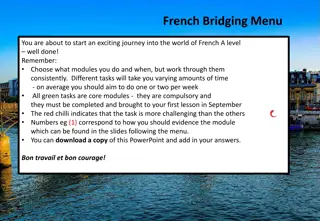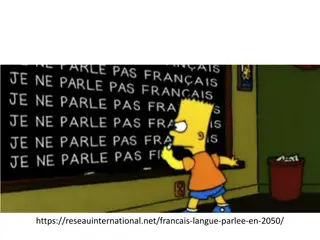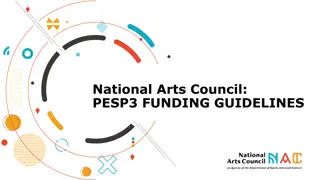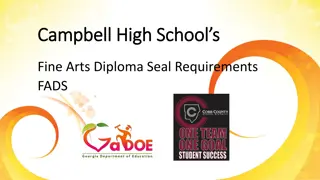Teaching French Culture Through Arts: Innovative Strategies for Educators
Explore creative ways to teach about French culture in the classroom through arts such as songs, folksongs, dances, and games. This session, led by Betty Lee-Daigle, a seasoned educator with expertise in teaching music and drama, provides practical tips and interactive activities for Core, Immersion, and Extended French teachers. Discover engaging techniques to incorporate the arts into your curriculum and enhance students' cultural understanding.
Download Presentation

Please find below an Image/Link to download the presentation.
The content on the website is provided AS IS for your information and personal use only. It may not be sold, licensed, or shared on other websites without obtaining consent from the author. Download presentation by click this link. If you encounter any issues during the download, it is possible that the publisher has removed the file from their server.
E N D
Presentation Transcript
H2 How Do We Teach About French Culture In Your Classroom Through The Arts? Saturday, April 2, 2016 12-1 pm Mississauga B International Hotel Betty Lee-Daigle, Greater Essex County DSB betty.lee-daigle@publicboard.ca
H2 How Do We Teach About French Culture In Your Classroom Through The Arts? For Core, Immersion, Extended; P/J teachers: Teach about French culture? Using French songs, folksongs, dances and games, these will be shared and discussed. Voice care will also be given as well as time to share other songs that the delegates might know. You may videotape the songs and dances to remember the melody.
H2 How Do We Teach About French Culture In Your Classroom Through The Arts? Betty Lee-Daigle, Greater Essex County District School Board 29 years teaching English Vocal and Instrumental Music JK-8, Core French Gr. 4-7, French Immersion Music JK-8 and Drama and Dance at 12 different schools, Interim VP for a year-Taught in English, Immersion, Dual-Track in various schools-11 in total This year teaching 5 FI Full-Day Early Years Music, Drama/Dance classes and joined in with another FI Full- Day Early Years classes, Gr. 1 and2 Music (both FI and English), Gr. 1 FI Drama/Dance classes and now teaching 3 English Music, 1 FI Gr. 1 Drama and Dance and 1 Phys Ed EY class and 2 DPA/Health Gr. 1 FI classes. Ensembles include Vocal Ensemble, Junior Choir and Handbells Ensemble FI Tecumseh Vista Academy, JK-Gr. 12 Dual-Track School with 10 classes of Early Years- 5th year in existence with 6 portables and 2 principals and 2 VPs-with 8 elementary portables and our secondary addition was completed as of February 2016 Number of Students from EY to Grade 12=1620 students Honours Music in Education (UWO), B. of Ed. (UWO), Diploma in Fine Arts in Kodaly Specialization (Calgary), Orff Pt. 1, Early Childhood Music Education (Royal Conservatory), Music Specialist, Special Ed. Specialist, Instrumental Music Pt. 1- Intermediate (AQ), Principal s Q Pt. 1 and 2 OMLTA conference presenter since 2008, OMEA conference presenter since 2015. OMEA Music Leadership candidate. Past Kodaly conference presenter, local board presenter, associate teacher, GECDSB Board Mentor, Committees-FSL, Music, JK-6 Music Chairperson in the Thames Valley DSB and in GECDSB
Fingerplays (Jeux de doigts) CRISS CROSS Actions: (in partners) Criss Cross With the index finger, make an X on the partner s back Tap shoulders with fingertips (3X) Crawl fingers from the bottom of back to the head Blow gently on back of head Hug partner gently Tickle partner on waist Sauce aux Pommes Les araign es grimpent sur ton dos Brise Fra che Une Grosse Caresse Maintenant je vais te chatouiller
Ouvre-les, Ferme-les Ouvre-les, Ferme-les, (2X) Donne leur un petit claque! Oui! Ouvre-les, Ferme-les, Ouvre-les, Ferme-les, Mets-les sur tes cuisses! Bouge-les, bouge-les, bouge-les, bouge-les Jusqu' ton petit menton! Ouvre ta pe-tite bouche! (pause) Mais laisse-les pas entrer. (vite) Open them, shut them (2X) Give them a little clap! Yes! (Keep hands up while opening and closing them!) Open them, shut them (2X) Put them on your lap! Creep them (4X) Up to your little chin! (Creep fingers up each arm to chin) Open up your little mouth! (Pause and open mouth) But don t let them in! (Put hands behind back) Do this song fast/slow, loud/soft, with a high voice/low voice, blubbery voice by putting index finger on upper and lower lips or no voice with actions. Once shown to the students, they can suggest which ways to do this fingerplay.
LArbre Dans Ses Feuilles by Zachary Richard http//:www.youtube.com/watch?v=jjj3bXK4nG8 C estl Halloween https://www.youtube.com/watch?v=XqcnxnEn2ME
POMME DE REINETTE (St. Pierre and Miquelon Folk Song) Pomme de Reinette et pomme d api Tapis, tapis rouge Pomme de Reinette et pomme d api Tapis, tapis gris. Cachez un poing derri re votre dos Ou vous aurez un coup de marteau! One Potato, Two Potato Game using a steady beat. All children have fists in front of their body. The teacher taps each fist. At the end of the song, whichever student s fist is touched last will be placed behind their back. When both of the fists are gone, they are out until you have one child left as the winner. Students who are out sit in the middle of the circle and play the game inside the circle. http://www.youtube.com/watch?v=rWJH1oltzZM
Frre Jacques Form one large circle or break up in groups of even number of people. Sing in unison and then in a round. Dance in groups of 8-10 people. Actions: Fr re Jacques, Fr re Jacques In a circle, step in 4 steps Dormez-vous? Dormez-vous? Step back 4 steps and go back to original circle Sonnez les matines. (2X) Bend knees and pull the rope of a bell with hands Din! Dan! Don! (2X) Turn half-circle while stepping on a spot and clap 3X simultaneously. All actions are done on a steady beat. https://www.youtube.com/watch?v=RXI7KEUbSxM
LAraigne Tik L araign e Tik monte la goutti re, Use index fingers and thumbs of other hand to crawl up in the air. Tiens voil la pluie, Tik tombe par terre, Use fingers to imitate rain. Mais le soleil, A s ch la pluie, Make a sun with the arms. L araign e Tik Remonte la goutti re. Crawl up again using the thumbs and index fingers. A student, one at a time can get a spider (Dollarama store) and have the student crawl the spider up the whiteboard or standing object. http://www.youtube.com/watch?v=WPboONnHd14
Violette Bicyclette 1, 2, 3, 4, 5, 6, 7, Violette, Violette, 1, 2, 3, 4, 5, 6, 7, Violette Bicyclette The handclapping game Stella Ella can be adapted to this song. The object of the game is to eliminate the people beside you at the end of the song. If Student 1 misses clapping Student 2 s hand on the word bicyclette , then Student 1 is out. If Student 1 touches any part of the hand of Student 2, then Student 2 is out. Palms face the ceiling. Right hand is placed above the student s hand on their right and left hand is placed below the student s hand on their left. https://www.youtube.com/watch?v=gpWYq2-eUPQ
Do R Mi DO - le do, il a bon dos R - rayon de soleil d or MI - c est la moiti d un tout, FA c est facile chanter, SOL la terre o vous marchez, LA l endroit o nous marchons TI (SI) siffler comme un pinson Et nous revenons DO Oh Oh Oh R p ter. Teach song in English if you want. Use tone bells so that they can see the sounds. We use also boomwhackers and glockenspiels/xylophones in the class to show them how the sound changes when the key is short (higher sound) and when the key is long (lower sound). They can eventually explain the sound is lower because the instrument is bigger or longer. If you have tone bells that are individual tones, then eight students can play a scale with the song while the class handsigns the solf ge. http://www.youtube.com/watch?v=_lw2dvsMgfo http://www.youtube.com/watch?v=e-y-Dm4Pxbw
Jai Perdu le Do de Ma Clarinette J ai perdu le do de ma clarinette (2X) (Show handsign do and march) Ah! Si papa, Il savait a, tra la la (2X) (continue) Il dirait Ohe! (2X) (Stop marching) Tu n connais pas la cadence (Shake first finger side to side) Tu n sais pas comment la danse, Tu ne sais pas danser (continue) Au pas cadenc (continue) Au pas camarade (2X) Au pas (3X) (March) Au pas camarade (2X) au pas (3X) (March) au pas (2X)_____ J ai perdu le r J ai perdu le mi do r mi fa sol la si do (Do handsigns for 4 beats each) Tu n connaispas .. (same actions as above and then do handsigns) http://www.youtube.com/watch?v=XXL_uFHDaCA
How to Play Rhythm Instruments Rhythm instruments should be introduced by the sound qualities or timbres. Children should be given the opportunity to explore the variety of sounds produced by the different substances, such as wood, skin and metal and show them the methods of producing the sound which are by shaking, striking, blowing, or rubbing that can alter its character. After the song is finished, the instruments need to be placed gently back onto the carpet/floor and after the class is over, they need to be returned by the wood family first, then the metals next, etc. in an organized fashion.
Rhythm Instruments Use rhythm instruments while singing to music in a circle or listening to French music Le bonhomme-gigueur (Limberjack)-Attach the bonhomme with the stick and sit on the flat wooden board. Place the boots of the bonhomme on the flat board which is between your legs. Tap the man on the flat stick on the steady beat of the song that you are singing and teach the students that the flat board is like a diving board. For variety, tap the same rhythm as the spoons. Teach the students to brush the board which their dominant thumb as if they are brushing dirt off their knee. Les Cuilli res (Spoons) ta titi ta titi ta titi titi titi challenging or just use the first two rhythms to teach an ostinato. Ta is always a downbeat. Down down up down down . Use the spoons to tap this rhythm. It is
Rhythm Instruments METAL TRIANGLE-have the students feel the triangle while the teacher taps the triangle by the knob- discuss how sound is made by vibrations. Triangles are tapped in the middle of the bottom bar using the metal stick. I show them how the sound deadens or rings when you hold the triangle directly and when you hold the knob. LES GRELOTS-BELLS -Shake the bells on the beat against the other hand or in the air. LE TINTEUR-JINGLE TAPS-Hold the handle and hit the wooden part on the palm of the other hand so that the jingle taps sound like a tambourine. LES CYMBALES-CYMBALS-Hold onto the knobs and hit them together. WOOD LES BATONNETS RYTHMIQUE-RHYTHM STICKS-Hit sticks in the shape of an X and only the top stick moves up and down on the beat. Students grasp the sticks in fists, not with a straightened finger on the stick. LES BLOCKS SONORES-WOODBLOCK-Hold on the knobs and hit the blocks together. You can also rub them but it does not make a loud sound. LES CASTAGNETTES-CASTANETS-Place fingers in the string and thumb at the bottom. TONE BLOCK-LES BLOCS DE BOIS-place fingers around the bottom of the woodblock and tap with the mallet with the hand that they write with on paper. LE TUBE SONORE-TUBULAR WOODBLOCK-grasp handle of woodblock and hit tube in the middle
Rhythm Instruments LES BLOCKS SABL S-SANDBLOCKS- Same as the woodblocks but you can also rub them to hear the sandpaper rub together. SKIN TAMBOURINE-TAMBOURIN-Place their thumb in the hole in the side of the tambourine with the hand that they do not write with and grip the instrument with their fist. The tambourine in horizontal. Tap the skin with the fingers flat and held together so the jingle discs sound. LE TAMBOUR-HAND DRUM-Same as the tambourine but there are no jingles on the side like there are on a tambourine. How to Teach Children to Use the Rhythm Instruments In a circle, I teach the students how to hold each instrument properly and respectfully. Before a song begins, they pick up their instrument at the same time and wait to play until the teacher(conductor) begins. The conductor counts them in with the conductor baton saying Un, deux, trois, quatre . After the students singing the song is finished, they place the instruments gently In front of them on the floor/carpet.
Am Stram Gram Am Stram Gram, (stamp three times with alternate feet) Pic pic Cole Gram (Point to partner with one hand on the beat) Bourr e, Bourr e, Ratatam, (held partner s hands and switch places) Am Stram Gram! (stamp three times fading partner) Pic! (clap hands and jump while turning a half-turn to a new partner) This is in a circle formation but the students face a partner. Each partner goes around the circle in the direction they are facing. Each action is stepping and moving on the beat. Each student will eventually meet their original partner. http://www.youtube.com/wvatch? =D3jZmWdcebs PATTYCAKE (Handclapping game) Pattycake, pattycake, boulanger Faites-moi un g teau, s'il vous pla t! Roulez-le et tapez-le et crivez un B Et mettez-le dans le four pour moi and b b ! http://www.youtube.com/watch?v=nSQUODxZqo0 This is a handclapping game with a partner. On the beat, clap your partner s hands and then your own for the first two lines and then do actions with the arms
Carnaval Carnaval, Mardi Gras, Carnaval, A _______(Name of school), c est tout un festival! Carnaval, Mardi Gras, Carnaval, A _______(Name of school), c est tout un festival! Use this song to pass out instruments to tap to the beat while they sing this traditional Carnaval song. http://www.youtube.com/watch?v=kWNvX07WdZw
Bonhomme, Bonhomme Bonhomme, Bonhomme, sais-tu jouer? (bis), Sais-tu jouer de ce tambour-l ? (bis) Boum, boum, boum de ce tambour-l ! (bis), Bonhomme! Bonhomme! Tu n es pas ma tre dans ta maison, Quand nous y sommes! le violon (violin)-zing la fl te (flute)-flut -le tambour (drum)-boum la trompette (trumpet) ta-ra-ta-ta-ta-les b tonnets (sticks) clack -le tambourin (tambourine), le bloc sonore (sound block)-les castagnettes (castanets) les maracas (maracas) les cymbales (cymbals)-les blocs sabl s (sandblocks), le xylophone (xylophone) les grelots (jingle bells)-le triangle (triangle) http://www.youtube.com/watch?v=Lq3IHKfl0W8
Je suis un Lapin Je suis un lapin Stand behind the teacher and tap right foot to the side on Je and la and return foot beside the other foot. Do this twice. Je suis un lapin Do the same as above but with the left foot. Un beau lapin Jump forward on beau . Jump back on lapin . Je saute! Saute! Saute! Make three jumps forward and repeat all of the above until the music ends. http://ca.video.search.yahoo.com/video/play;_ylt=A2KLqIgZxCVTwHQAe0U WFQx.;_ylu=X3oDMTByZWc0dGJtBHNlYwNzcgRzbGsDdmlkBHZ0aWQDBGd wb3MDMQ-- ?p=youtube+on+bunny+hop&vid=1891b8739e0d448550b4485132ca5fe1&l= 3%3A07&turl=http%3A%2F%2Fts2.mm.bing.net%2Fth%3Fid=VN.607
French Musicians/Resources Alain le Lait tienne-La Salle de Classe Folksongs of Canada Richard Johnston-ethnomusicologist Edith Fowke-ethnomusicologist Suzanne Pinel- Noel, Vive le Vent, Quand le P re No l Carmen Campagne-L Arbre dans ses Feuilles, Bonhomme AIM-Wendy Maxwell Jacquot-Je t aime beaucoup (Skinnamarink), Jouez au Hockey Beebo-Saute comme ci, Saute comme a, Fais le cha-cha-cha Gilles Vigneault F lix Leclerc Zol o-C est le printemps Juli Powers-Les mois de l ann e Smithsonian Folkways.si.edu-M tis music
Voice Care Always drink water or have a flask of water to replenish yourself. Once the children know a song, stop singing the songs with them and only give them a starting pitch and help at the beginning of the verses or lines and then stop completely once they know it well. Never sing when you have a sore throat and do not whisper. Use a recorder, xylophone, tuning fork or pitch pipe to start the children if you have no voice. You can mouth the words instead.
Jai Tant Dans J ai tant dans , j ai tant saut Dansons ma berg re oh gai J en ai d cousu mon soulier l ombre Refrain: Dansons ma berg re joliment Que le plancher en rompe (bis) 2-J en ai d cousu mon soulier Dansons ma berg re oh gai J ai t trouver le cordonnier l ombre Refrain
Jai Tant Dans (Circle Dance) 3-J ai t trouver le cordonnier Dansons ma berg re oh gai Beau cordonnier, beau cordonnier l ombre Refrain 4-Beau cordonnier, beau cordonnier Dansons ma berg re oh gai Veux-tu raccommmoder mon soulier l ombre Refrain There are 9 verses altogether. In groups of 4, number each person from 1 to 4 and hold hands. Circle to the left for 8 beats and then switch directions to the right for 8 beats. Stop and face the inside of the circle. During the refrain of the song, choose number 1 performer to begin putting the right hand in front of themselves in the center of the circle and the rest of the group will put their right hands on top of each other s hands that are in the middle and go counterclockwise.
Contra Dances with Reels Use with any traditional French folk music with 4 verses of 16 beats in each verse You need to teach the students the terminology of the head couple, foot of the set (line), through the wicket (proceed under the arched arms of the head couple) and peel the orange (the two lines peel off to meet at the foot of the set) . The one basic step unique to contra dancing also needs to be taught. This is the weaving motion in which the head couple swing each other with their right arm, then move to the next person in the facing line with their left arm and then returning to their partner with a right-arm swing and so on down the entire line. That s why it is called a reel. Give PRECISE DIRECTIONS. Look at YOUR line. You are NOT going to swing any of those people! Look at the line ACROSS from you. You ARE going to swing all of those people! Which arm will you use to swing your partner? (RIGHT ARM) Which arm will you use to swing all of the other people? (LEFT ARM) ALWAYS swing your partner again after swinging anyone who isn t your partner! Walk the students through this step before expecting them to perform it in time to their singing or before you play a piece of folk music.
Folksongs to Use in your Classroom Brave Wolfe-Song about General Wolfe s death during the victory of Battle at the Plains of Abraham in 1759 that made Canada British. Un canadien errant (Once a Canadian Lad)-This song is about one of the lads who was banished because he was a rebel so he had to flee to the US after the rebellion of 1837. A popular song with all French-Canadians. En roulant ma boule-Originally from France in the 15th century, it became a paddling song of the voyageurs and coureurs-de-bois. C estl aviron (Pull on the Oars)-An ancient French ballad where the canoement added the paddling refrain to lighten the monotony of paddling from daybreak until dusk. Les raftsmen-A lumber camp song that catalogue life in the woods. Dans les chantiers (The Winter Camp) is another which describes the log huts where the men lived and where the English terms shanty and shanty-boy came from.
More Folksongs Ah! Si mon moine voulait danser! (Come and Dance with Me!)- Voyageurs danced to this song when they gathered in the evening at the fur-trading posts. The song is about the inducements which a young lady offers a monk in an effort to get him to dance. Over time, children sang this while they spun their tops. Alouette!-This song is about a skylark. I will pluck your head, beak, nose, eyes, neck, wings, back, feet and tail. The Huron Carol (Jesous Ahtonhia)-It is believed that this is the first Canadian Christmas carol. Father Jean de Br beuf might have written the Huron words about 1641 to teach the indigenous people about the Christmas story. It is set to the melody of a 16th century Christmas carol. J.E. Middleton, a Canadian poet wrote the English words. la claire fontaine (By the Clear Running Fountain)-Early explorers and coureurs- de-bois used it as a paddling song and the habitants and their wives sang it as they cleared their land along the St. Lawrence River. After New France became British, the French-Canadians vowed that they would never forget their homeland. It is believed that the men of Champlain s Order of Good Cheer sung this song at Port Royal in 1609. Fais do do (Go to Sleep)-This is a popular French lullaby.
More Folksongs, Dances, Singing Games Vive la Canadienne! (Of My Canadian Girl I Sing)-popular song toasting the Canadian girl Napol on J entends le Moulin Le Petit Navire (Little Sailor) En passant par la Lorraine
